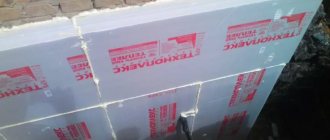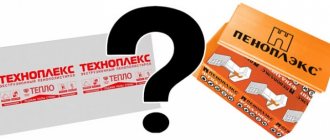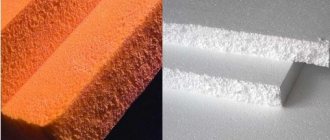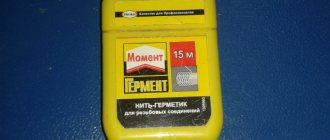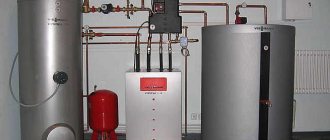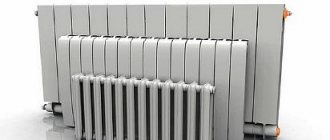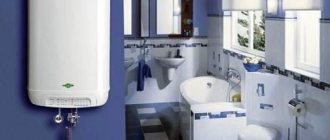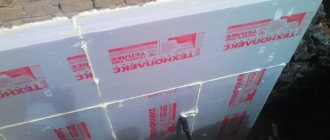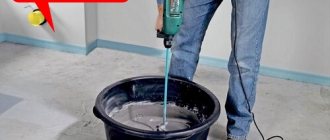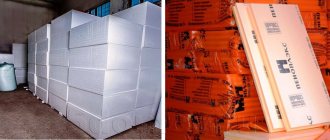Any capital construction at some stage requires insulation. The modern assortment is filled with materials of varying degrees of thermal conductivity and price range. To choose the right option, you need to familiarize yourself with their main features. The favorites in the thermal insulation market are insulators based on polystyrene foam, an environmentally friendly, non-flammable polymer. Technoplex and Penoplex are the most popular today.
The differences between brands are small, which can make choosing one over the other much more difficult. However, some differences in characteristics will help you choose the right insulation.
Features and Specifications
Penoplex thermal insulation is a board made of extruded polystyrene foam. A boutique materials company specializing in the production of synthetic insulation for a variety of roofing, foundation, wall and interior applications. For example, Penoplex 45 is supplied only to industrial sites and is used as thermal insulation for loaded structures, railways and roads, and airport runways.
The presented products in this series have reliable strength, resistance to biological influences, low thermal diffusivity and zero water absorption. Considering the manufacturer’s description, such insulation does not burn from environmentally friendly components without the addition of phenol-formaldehyde resins. This ensures a healthy indoor climate and a guaranteed service life of 50 years.
Radiator "Technoplex" produces a wide range of TechnoNIKOL products in the field of goods, including roofing, construction chemicals, special equipment and much more. Extruded insulation has proven itself mainly for interior work - insulation of partitions, balconies, floors. It is even used in installations of thermally insulated floor systems.
During the production of Technoplex, graphite nanoparticles are added to the same polystyrene foam, which, in turn, reduces thermal conductivity. Consequently, according to the manufacturer, the stability of Technoplex properties throughout its entire service life, reducing water absorption and vapor permeability. Neutral, biostable, practically non-shrinking polymer material takes care of gasoline solvents and bitumen adhesives. Well suited for use under plaster.
Insulation of external walls of a residential building ↑
If, when insulating the external walls of a house, you make a choice of material, then it would be better to take foam plastic rather than penoplex, because polystyrene foam is cheaper and has greater breathability, which in many cases allows you not to make a separate internal vapor barrier with expensive materials, while getting a completely “breathable” » wall.
Vapor permeability
Polystyrene foam, compared to penoplex, has slightly higher vapor permeability, which is not always good.
By the way, it is useful to listen to the opinion of a specialist about the vapor permeability of polystyrene foam, because many people are confused about these issues, and there are different brands of foam plastic, so I recommend watching this short but quite informative video:
Comparison of main parameters and prices
To choose the necessary thermal insulation, you should correctly navigate the purpose of the material, based on its composition and characteristics. For clarity, the comparative technical characteristics of polystyrene insulation are given in the table below.
| characteristic | Technoplex | Penoplex |
| Length m | 1.18 i 1.20 | 1.20 i 2.4 |
| Width, m | 0.58 i 0.6 | 0,6 |
| Thickness m | 0,02-0,1 | 0,02-0,1 |
| Compressive strength, kPa | 150-250 | 200-500 |
| Thermal conductivity, W/mK | 0,032 | 0,030 |
| Density, kg/m3 | 26-35 | 25-47 |
| Temperature, ° C | from -70 to +75 | from -50 to +75 |
| Water absorption, no more,% | 0,2 | 0,4 |
| Thermal conductivity at (25 ± 5) ° C, W / (m * K) | 0,032 | 0,030 |
| Vapor permeability, mg/m * hour * Pa | 0,018-0,02 | 0,02 |
A review of the metrics indicates similarities in the isolation of this class. As for the difference between them, it indicates the direct place of use.
Both heat insulators have a number of common properties:
- the thermal conductivity coefficient is better compared to stone wool or foam;
- lightweight and does not require special qualifications for installation work;
- they are not afraid of attacks by rodents, insects, fungi or other biological factors;
- damaged by solvents and bitumen glue;
- more or less equal price range.
The level of strength of the materials, according to experts, is more or less the same. However, unlike Penoplex, due to the presence of nanoparticles in the composition, Technoplex is considered more resistant to mechanical stress. However, as practical tests show, with strong static bending, the strength coefficient of Penoplex is 0.4-0.7 MPa, and Technoplex - 0.3 MPa. Hence the conclusion: the resistance to high loads of the first is much better than that of the second insulation.
Another difference concerns the operating temperature range. For Penoplex this is -50 - + 75 ° C, and for Technonikol, respectively -70 - + 75 ° C. It is worth noting that our latitude is not -70 ° C, so this difference is insignificant.
You can purchase thermal insulation materials of both brands at the prices indicated in the table below:
For each specific case, the basic requirements for thermal insulation force us to choose TechnoPlex from Technonicol or Penoplex. The decision is based on the area of application and personal preferences of buyers. So, if Technoplex is better to buy in private construction, Penoplex has a wider range of applications. Depending on the marking, it is equally suitable for industrial buildings and road works.
Penoplex and mineral wool are materials inside and outside buildings with the same properties, but each is better suited for specific conditions of use and has special advantages.
Mineral wool is a material made from fibers formed during the melting of rocks, significantly superior in its properties to the well-known glass wool.
Penoplex is a more modernized foam material, which, in most characteristics, largely overlooks its predecessor. It is significantly inferior to it only in cost terms.
The production technology and composition of both radiators are radically different.
Comparing expanded polystyrene foam with other insulation materials
The main competitor for such materials are felt and fiber insulation. Some prefer to use mineral wool, others prefer Technoplex or Penoplex. Which is better, penoplex or mineral wool for insulation? Each of the materials has its own positive and negative properties. In the photo below you can see the features of expanded polystyrene foam.
Like mineral wool, they are durable, safe and environmentally friendly. True, the thermal insulation qualities and moisture absorption of mineral wool are worse.
Private one- and two-story premises are best treated with Penoplex. It is much more effective. Mineral wool is used for finishing high-rise buildings. The fact is that it does not burn at all. Fire retardant additives will not be able to protect EPPS 100%; mineral wool is better in this regard. However, it is not recommended to use it in damp and damp areas.
Another competitor for EPPS is isolon. This is insulation made from foamed and modified polyethylene. Some people ask, Izolon or Penoplex, which is better? Izolon is suitable for insulating internal walls and ceilings of a building. And the thermal conductivity coefficients of the materials are almost the same. Izolon can withstand heating up to 80 degrees Celsius throughout the day. The material has excellent sound and noise insulation. It is safe and environmentally friendly. When heated, it will not emit harmful substances. The main disadvantage is the softness and flexibility of Izolon. When laying it on the wall, it requires fixing with sheets of plasterboard or MDF boards. You cannot glue wallpaper or plaster on Izolon. This is why it is recommended to use it in conjunction with EPS insulation.
You can also find the following queries on the Internet: Ravaterm or Penoplex, which is better, Polyspen or Penoplex, which is better, or Stirex or Penoplex, which is better. It is impossible to answer the question unequivocally. All of them belong to XPS and have almost identical characteristics. The difference is the price and some additional nuances.
Comparison of main parameters
- Thermal insulation.
Mineral wool has a coefficient of 0.032-0.046, while penoplex has a coefficient of 0.03-0.032. The lower the index, the better, since the room maintains less heat loss and a better temperature.
- Duration of the operation.
Penoplex is a fairly hard material that does not rot, dry out or crumble. Insulation has a long service life under appropriate storage conditions when it is well protected from prolonged sunlight and excessive heat. Mineral wool also does not dry out. Without exposure to high physical exertion, it can last a long time, it is not afraid of high or low temperatures and prolonged exposure to the sun on the surface.
It is not threatened by mold and other pests in the body, and it is not susceptible to destruction by rodents. But mineral wool can crumble and settle on the wall. In general, both materials have a long service life, lasting at least 50 years.
- Environmentally friendly.
Both materials are manufactured without the use of hazardous ingredients that could be harmful to human health, but absolute sealing is still required to protect the respiratory tract.
- Convenient installation.
When insulating a perfectly smooth surface, working with Penoplex is much faster. It is lightweight, easy to cut and sand, and has L-shaped edges to eliminate cold bridging. When using it, there is no need to create a vapor barrier. If the edges of the razor groove are missing, sanding the seams or applying them in two layers is boring, resulting in unnecessary costs.
Mineral wool is slightly heavier but is much more efficient and simplifies installation due to the existing disproportionate cross-sections and designs. But when working with it, you must first buy special clothing along with a respirator and goggles.
- Which material is warmer?
When used to heat the facade of a house, if the penoplex is 50 mm thick, then to achieve a similar effect the mineral wool should be 60 mm thick. The difference is not dramatic enough. Depending on the situation, each of them is good in its own way, because cotton wool is capable of allowing air to pass through, unlike penoplex, which has an absolutely airtight structure.
- Moisture absorption.
Mineral wool absorbs much more water and then loses some of its thermal insulation properties. In this case, penoplex is much better, because even with intense and frequent rains its mass practically does not change.
Mineral wool has the best performance in this parameter because it hardly ignites. Its melting point must be greater than 1000°. Cotton wool contains an adhesive base that can catch fire, but it is a very small part of the total volume of the material and does not pose a significant risk.
Penoplex has completely different functions. It is capable of melting, opening a flame and burning, releasing human toxins that are very harmful to the body. To ensure a high level of fire protection for buildings, penoplex is categorically not suitable for use. For this, the best and absolute option is mineral wool.
- expenses
The price of materials is practically the same. The slight difference may only depend on the choice of manufacturer.
Common features
If you analyze the technical indicators of both insulation materials, you will notice that they do not have decisive differences:
- Temperature regime (considering the fact that in the CIS countries temperatures of -70°C rarely occur).
- These materials are heat-insulating and also environmentally friendly.
- In fact, they are not subject to dissolution in both water and soil.
- Used for individual construction and subsequent thermal insulation.
- They are destroyed when exposed to solvents and bitumen glue.
- Lightweight.
- They do not require special skills for installation work.
- Approximately the same price segment.
The better to insulate with cotton wool
Mineral wool is ideal for buildings made of breathable materials such as wood or brick. In general, it goes well with all coatings and there are no exceptions.
In some respects, materials clearly differ, and their selection must be made based on the conditions in which they will be encountered. It is almost impossible to determine which one is better because each of them is good in its own way.
A reliable insulating material widely used in industrial and private construction is extruded polystyrene foam. It can be found under the names extruded polystyrene foam or XPS. In addition, manufacturers' trademark names are often used for the materials they produce.
So, Penoplex, Technoplex, Stirex slabs are all the same extruded polystyrene foam. One of the most famous companies on the Russian market for the production of polymer-based building materials is the Penoplex company. He started working about 15 years ago and has already earned respect - today products made from extruded polystyrene foam occupy about 50% of the entire market of thermal insulation materials in Russia. In addition to the traditional low thermal conductivity, minimal moisture absorption and high compressive strength, Penoplex boards are also of good quality. They are used to insulate structures from the foundation to the roof: baseboards, basements, walls, floors, roofs. The production of sandwich panels with penoplex as a heat insulator began. Penoplex reviews are the best, and its price is quite affordable.
However, before using an unknown material, each owner will first analyze his opinion: what are the reviews of workers, builders, consumers, friends and neighbors who have used this type of penoplex? For Penoplex isolation reviews we will search on the Internet: what is the price / quality ratio? Is he easy to work with? Is it worth it to insulate walls, floors, soil or material for individual rooms? Is it better to look for other options (foam, mineral wool)?
Opinions on penoplex wall insulation
It is known that heat loss through walls can reach 45%. High-quality insulation will solve this problem. Extruded polystyrene foam is very convenient for insulating walls, both inside and outside. Penoplex can be glued to wallpaper and plaster. Checking the insulation of penoplex walls is called a simple and pleasant thing, because the slabs already have grooves ready for connection - all that remains is to connect them. They cut well, allowing you to cut them to size using a simple jigsaw.
As for insulating walls with penoplex, he unanimously assesses that this issue is much less problematic than using, for example, mineral wool. An additional advantage compared to polystyrene foam is better thermal insulation characteristics and high density, and thanks to other modern good insulating materials for external walls, Penoplex has a different price - extruded polystyrene foam is cheaper.
- “They recently isolated a country house. Effortlessly, within two days, he covered 60 squares of foam. The boards fit perfectly and are a pleasure to work with. All that remains is to plaster and that's it.
- “50 mm of expanded polystyrene has thermal insulation properties equal to the width of a brick. What do you think is easier: to build a house or hide the slabs? Is it cheaper? I don't see any options - only plates. "
When it comes to opinions on insulating penoplex from the inside, most here agree that it should be done if it is not possible to insulate from the outside. We're talking about garages, basements, interior partitions, etc. What is this about? Judge for yourself.
- “Isolating from the inside is dangerous and side effects may occur. Especially if it is thick and uses a vapor barrier film, and when Penopleksse does not have a vapor barrier at all. "
- “How do you hang a closet on your polystyrene walls, excuse me? You will have to choose the concrete itself and then, that is, everything else, as well as another 5 cm of insulation.
- “And we won’t hang anything on this wall. We need insulation because the neighbors have a bathroom here, especially at night... you know what we're listening to. "
There are other problems too. How to stick wallpaper on penoplex - there were reviews on this too. As a rule, they lay the sickle mesh on the plates, cover it, and then trim it as desired. But can you stick wallpaper directly onto plates if you don't have time to finish them?
- “You can do everything and stick wallpaper on penoplex as well. But it is better not to do this, as this will affect the strength of the wall surface. The best solution is a wooden frame and drywall, and wallpaper can be easily applied to it. Or this option: front mesh plus kit.
- “Penoplex is an additional insulation material and is not intended for this type of finish. In addition, fire safety requires that the interior of the room be made of non-combustible material. "
Insulation of floors and foundations with peneplex
Let's now look at the opinions of those who have installed polystyrene foam on the floor - there are many opinions on this topic, because heated floors are quite common, and polystyrene foam is suitable for their devices. It is compatible with electrical devices and also serves as a screen that reflects heat and prevents the neighbors from heating up below.
What should a penoplex screed look like? The reviews here do not contradict the manufacturer’s recommendations. Its thickness is from 5 cm, it is often required (when laying, for example, tiles, laminate), but with the help of a device with a wooden floor you can do without a screed. You don't have to worry about damaging the panels under the weight of the furniture - this material is even used to insulate floors in garages, where the loads are, of course, quite significant. In general, we can say about those who have used penoplex - heated floors receive good reviews.
- “I was interested in Penoplex floor insulation - I looked at the reviews and decided to apply it. Compared to foam, it’s heaven and earth to get at least thickness, and I didn’t have to raise the floor an additional 5 cm. Place the screed on the foam plastic on top of the laminate. Soundproofing plus warmth. I was especially interested in the neighbors - it actually became quieter. My child, of course, still stomps, but the audibility is not the same below. "
- “They built a dacha - they put polystyrene foam on the outside walls and floor. It lasts for several years, so far everything is good and warm. They did not install a stove and, like a neighbor, they installed “warm floors” - they came and turned on the hum. By the way, penoplex is not much more expensive than polystyrene foam. "
As for insulating the foundation with penoplex, the opinions of manufacturers show that there is nothing better than this material. Extruded polystyrene is almost ideal, it solves problems such as waterproofing layer protection, groundwater drainage, etc. It is not biodegradable. Penoplex for foundation insulation is used in industrial construction in all climatic zones, including the Far North; it is also popular in private housing.
General advantages and disadvantages of penoplex
Advantages of extruded polystyrene foam advertised by the manufacturer:
- Low thermal conductivity and vapor permeability
- High compressive strength
- durability
- No water absorption
- Ease of use
- Environmental friendliness
- Burn Resistance
The last two points are controversial among consumers, and opinions about Penoplex differ here. Some doubt its environmental friendliness. Fire safety also raises questions.
- “Although manufacturers of extruded polystyrene claim a low risk of fire, it is worth remembering about opacity. Expanded polystyrene and bitter smoke when suppressed. And the mice bite him
- “Polystyrene is just as harmful as plastic windows, vinyl wallpaper, laminates, etc., because all these materials are somehow related to polymers. All of them change their properties under the influence of the sun, and polystyrene foam is no exception, so it is necessary to cover it with finishing. It is better to install expanded polystyrene to insulate the walls outside rather than inside the house, thus minimizing damage caused by decomposition products. "
- “It's cut, drilled, sawn, no formwork needed, not heavy...what else? They say that it is harmful just like building materials are not harmful? Tree? And how fat should she be? Overall, I am completely satisfied with Penoplex.”
Another area often referred to as penoplex is insulation - opinions vary. Some say that penoplex is an excellent sound insulator, others do not see such properties in it. It would be correct to say that this material, of course, absorbs noise, but if the task is not to insulate the walls and floor with penoplex, namely sound insulation, it is better to use other materials specifically designed for this. However, one does not exclude the other.
Let's summarize. Consumer reviews of Pro Penoplex are mostly positive. The ease of working with this material, the versatility of its use and its affordable price are forcing more and more craftsmen to look in its direction. Opinions about the insulation of walls and floors using penoplex, left by employees who dealt with this insulation, draw attention to the ease of laying and installing the slabs. The production of extruded polystyrene foam is cheap, which has a cost effect, which allows penoplex to be classified in the low price category among construction insulation materials. It is no more or less safe for the environment than other polymers, from which not only building materials are currently produced, but also dishes, toys, etc. As for flammability, it should be remembered that penoplex is not a finishing material, but with insulation, which must be hidden from external influences. It is really very good and has unique consumer properties that made it popular. Increasingly, extruded polystyrene foam is used for home insulation - insulation with unique properties. This material is already deserved...
Harmful or not
Insulation under siding
You can find a variety of reviews on this issue, but you need to understand that if the material is mounted outside, then there can be no harm from it. Inside, such materials are subject to additional insulation, so the question of their harmfulness during operation is also irrelevant.
First of all, when they talk about the dangers of a particular material, they mean fumes during its operation. If the material is protected, they will not be able to penetrate outside. Penoplex usually undergoes additional finishing. For example, to protect it from ultraviolet rays it is covered with siding, and after plastering the walls it is covered with paint.
Let's consider the question of the dangers of penoplex during a fire. It turns out that people often die not from fire, but from harmful fumes, so it is recommended to install it outside.
If you are concerned about the question of whether mice chew penoplex, then there is simply no better remedy for them than a cat. Mice chew on anything, even concrete.
Is penoplex harmful and you will learn the answers to some other controversial questions about this material from the video:
https://youtube.com/watch?v=Ea94bC7aIp0
Technoplex XPS and penoplex - what is the difference and what is needed as a layer of warmth on the floor?
We have to do the floor. The apartment is on the ground floor, below is a heated basement. We think about it: sound insulation on the slab, then a thin screed. The expert recommends EPPS with a density of 45 cm and a thickness of 3-4 cm. But on the Internet I find two types of similar insulation - technical density XPS 30-38 and orange penoplex with a density of 25-30. Explain the situation and tell me what material is needed for this work? Thank you.
The floor uses Epps (extruded polystyrene foam) with a density of 45. The walls use EPPS with a lower density because it is not static load bearing.
« The specialist recommends EPPS 45 density, 3-4 cm thick.
»
Do you doubt the competence of this specialist?
No, I have no doubt. I just didn’t find this density. And I don't know what I indicated, is it extruded or not, what is needed?
It's repressed. And it's still not compressed—it's foam. White like, made of small balls. and its density is even lower. There is no need to lay it exactly on the floor.
Everything is clear, so you need to find the right density. Yes, also, and do you need to install a metal grille for rigidity?
The mesh is necessary - both in terms of rigidity and strength of the surface of the plaster layer.
No questions yet, thank you very much for your advice and patience, but all the repair work is ahead of us, so you should worry about it.
Technoplex XPS and Penoplex - what is the difference and what is needed, like a layer of heat on the floor, repair ideas
We have to do the floor. The apartment is located on the ground floor, downstairs in a heated basement. We think about it: soundproofing on the slab, then a thin spout. The expert advises EPPS with a density of 45 and a thickness of 3-4 cm. But on the Internet I find two types of similar insulation - technoplex
TechnoNIKOL and Penoplex are the main producers of extruded polystyrene foam in the Russian Federation, their products are rightfully in demand in private and industrial construction. Their cost, performance parameters and performance are very similar in many ways, the question of which brand is better is very important. Some users believe that there is no difference between Technoplex and Penoplex, and the only difference is the color and size of the tiles, while others provide important arguments in reviews in favor of the chosen manufacturer. Finding the truth will only help you compare the scope and properties.
Technoplex is a specialized brand of polystyrene foam from TechnoNIKOL, produced by extrusion with the addition of graphite nanoparticles. This insulation is manufactured in the form of dense, non-shrinkable, silver-colored panels in standard sizes (it’s worth noting that you can purchase Technoplex tiles in other sizes after consulting with the manufacturer). The recommended scope of application mainly relates to interior work: insulation of floors, balconies, partitions and ceilings.
Penoplex is produced using the same method, but thanks to the introduction of fire retardants in some brands. This allows you to significantly expand the operating range, making it almost universal. It is recommended to choose this building material when protecting foundation structures from freezing (including burial) for insulating roofs, floors and facade walls. The size of the tiles in Penoplex is always the same: 1200 × 600 mm, thickness varies from 20 to 150 mm. The insulation color is orange.
Both varieties tolerate temperature changes well, retain a stable shape and properties during operation and are resistant to biological influences. Both technoplex and penoplex have plates with an L-shaped edge; it is recommended to buy them, if necessary, to eliminate cold bridges. Like any other XPS polystyrene foam, they are resistant to organic solvents and compounds with toluene and acetone, but are inert towards other chemical reagents.
Penoplex is represented by 10 brands for private and industrial use, TechnoNIKOL - 9 (including only one Technoplex). A review of the range shows that Penoplex accepts professional projects and its competitors. Despite loud statements from manufacturers, there are no radical differences between brands. The average cost of 1 m2 of Penoplex insulation with a thickness of 50 mm is 230 rubles, for Technoplex with similar properties - 176, but in the case of wholesale purchases or purchases from third parties, this difference is partially eliminated.
The results of comparison of the main characteristics, taking into account the declared data of the manufacturers, are summarized in the table:
| Technoplex | Penoplex | |
| Initial density limits, kg/m3 | 26 to 35 | 25 to 47 |
| Minimum thermal conductivity, W/m K | 0,032 | 0,03 |
| Water absorption by volume,% | 0,2 | 0,4 |
| Vapor permeability, mg/m h Pa | 0,01 | 0,012 |
| Flammable group | G4 | G3 and G4 |
| Dimensions: L × W | 1180 x 580 | 1200 × 60 |
| Plate thickness, mm | 20, 30, 40, 50, 60, 100 | 20, 30, 40, 50, 60, 80, 100, 120, 150 |
| Modulus of elasticity, MPa | 17 | 15-18 |
| Compressive strength at 10% deformation, MPa, not less | 0,2-0,25 | Depending on the brand: from 0.12 to 0.3 |
| Operating temperature, ° C | -75 to +75 | -100 to +75 |
Analysis of indicators shows that Technoplex is more resistant to moisture and steam and is not inferior in strength. Thanks to the introduction of fire retardants into the composition, Penoplex wins in terms of fire safety, although the upper limit of the operating temperature is the same. The materials also protect rooms and buildings from heat loss (with the slight advantage of Penoplex).
When building a house in Russia, owners consider its insulation. Currently, there are a large number of elements on the insulation market, and tile insulation products are available upon special request. Technoplex and we have established ourselves among them. To better understand their properties, it is necessary to make a small comparison of the main characteristics.
4 Vapor barrier floor screed
The situation with floors is ambiguous and depends on environmental conditions. So, a screed on a balcony or loggia should be protected with a vapor barrier, but special conditions arise there.
Interfloor ceilings do not need to be protected from the floor side. Several factors have an influence here.
Firstly, the technology of installing foam plastic on the floor itself makes it possible to fit and insulate it well. Secondly, the screed must be waterproofed, and the waterproofing layer also helps protect against steam.
And you should understand that the load on the floors is very small, since according to the laws of physics, warm air and steam always tends upward. Below, it does not linger, being replaced by colder air.
Ceiling insulated with polystyrene foam boards
Again, all exceptions are the finishing of floors above a bathtub, bathhouse, etc. Here the amount of steam can reach critical levels and even pass through concrete interfloor ceilings.
Composition of materials and method of their manufacture
Extrusion or penoplex refers to plate heat insulators. This is done by displacing polystyrene.
This method allows you to obtain a homogeneous structure of the material, consisting of tiny cells with air. During production, polystyrene granules are mixed at high temperatures and pressures, and a blowing agent (light carbon dioxide CFCs) is added to the mixture. The next stage of production is the extrusion extruder. The resulting material has good thermal insulation properties. Technoplex is also a material for thermal insulation of tiles. During production, graphite nanoparticles are added to the extruded polystyrene foam, which further reduces the material's thermal conductivity while increasing its strength.
Both materials are environmentally friendly, do not support combustion, and do not dissolve in water and soil. They are suitable for private construction, insulation of balconies and equipment for “warm floors”.
Briefly about the main thing
Insulation plays an important role in construction and renovation. You can find a huge number of insulation materials on the market, each of which has its own characteristics and disadvantages.
“Technoplex” and “Penoplex” are similar in technical characteristics. Both materials have high density and can withstand significant weight, and are characterized by low vapor permeability and thermal conductivity. They also have similar disadvantages. Both insulation materials ignite easily and release hazardous substances.
The choice is most often made in favor of Penoplex. This is due to the low price and the ability to use sheets for external insulation.
Other materials can be used for insulation: mineral wool, polystyrene foam and others. Each of them has its own characteristics.
Strength of materials
In terms of mechanical compressive strength at 10% strain, Penoplex (type 35) and Technoplex XPS30-200 Standard have the same performance of 250 kPa. This value depends on the density of the plates.
The tensile strength during static bending in Penoplex, depending on the type, is 0.4-0.7 MPa. The same figure for technopex is 0.3 MPa. We can conclude that penoplex is more resistant to static bending because it can withstand greater loads.
Thermal insulation of flat roofs
Flat roofs are usually insulated with polystyrene foam due to its resistance to mechanical stress.
The material is also applicable to pitched roof types, but for them experts often recommend the use of fiber insulation. Mineral wool and glass wool better fill the under-roof space, which eliminates the appearance of cold bridges.
Preparatory work and waterproofing
Before installing thermal insulation, it is necessary to prepare the insulated surface. It should be dry and clean. The old backfill is removed. Then the waterproofing film is laid.
This is necessary to ensure that moisture does not accumulate between the insulation and the roof, which can lead to mold, rotting of wooden structures and corrosion of metal elements.
It is important to install the film so that there is a gap of 2 cm between it and the sheathing to remove moisture
Installation of insulation
Foam boards are laid on top of the waterproofing. They can be secured using glue, liquid nails, anchors, dowels, or flooring. For additional reliability, mounting in several ways is possible.
When laying insulation, care must be taken to ensure that there are no voids and that the slabs are tightly adjacent to each other.
The resulting cracks must be filled with foam.
Covering with geotextile material and gravel
Geotextiles are laid on top of foam boards. It protects the roof from the negative effects of the sun and reduces the effect of mechanical loads. As a result, the service life of the roof is increased.
Following the geotextile is backfilling with gravel, the fraction of which is 16/32. The thickness of the layer should be at least 5 cm. A cement-sand screed is made on top of the gravel.
Thermal conductivity and water absorption of penoplex and technoplex
The thermal conductivity of penoplex, depending on the type and operating conditions (A or B), does not exceed 0.028-0.031 W / mK. This indicator for the technoplex under various operating conditions is 0.031 W/mK. Thus, both materials are effective thermal insulators.
Water absorption of Technoplex has a volume of no more than 0.2% in 24 hours. The water absorption of penoplex (type 35) is only 0.1%. Penoplex, immersed in water for 28 days, increases by only 0.2% of its volume. This means that the penoplex absorbs little water.
In addition, this material is able to retain its properties after a large number of defrosting and freezing cycles. For example, after 1000 such cycles, penoplex changes the thermal resistance by only 5%.
Cost of products
Penoplex wins this confrontation. It is about 10% cheaper than its brother. At large volumes, this minor difference becomes quite significant. Therefore, in order to save money, it is better to choose the first option. The price in each region of Russia may be different, this should be taken into account.
With all this, we can conclude: each of the insulation materials is an excellent option. They are similar in their characteristics, but, nevertheless, Penoplex is a little better. It turns out that for a lower price you get high-quality insulation material. It is versatile and can be used for different purposes. Technoplex or Penoplex, which is better? Reviews say that each of the materials is good.
Tips for choosing
To ensure that the quality of insulation with TechnoNIKOL extruded heat insulator meets the necessary requirements, it is worth taking note of several recommendations.
It is necessary to pay attention to the markings. It indicates the purpose of each material. The purchase should be made in a trusted store with positive customer reviews. You can scroll through the comments of professional construction experts in advance
In addition to the advantages, they usually indicate the disadvantages of a particular material.
The material is selected taking into account a special calculation. This will allow you to buy the right quantity. The formula is quite simple: the height of the walls is multiplied by the perimeter of the walls, then multiplied by the thickness, and then multiplied by the mark indicated by the manufacturer on the cubic meter marking. With a wall height of 3 m, a perimeter of 24 m, an insulation thickness of 5 cm (0.05 m) and a packaging volume of 0.36 m3, the result is:
- 3 x 24 = 72 (m2);
- 72 x 0.05 = 3.6 (m3);
- 3.6/0.36 = 10 (packs).
You will learn more about TechnoNIKOL Carbon products in the following video.
Easy to use, easy to buy
Penoplex is produced at factories under the same name in Perm, Leningrad region (Kirishi), Novosibirsk, Taganrog and Irkutsk. This manufacturer has 10 official representative offices in all federal districts of Russia.
Technoplex is produced at the enterprises of the TechnoNIKOL group of companies in Mineralnye Vody, Novoulyanovsk, Uchaly (Bashkortostan), Ryazan, Yurga (Khanty-Mansi Autonomous Okrug). And also has 10 representatives throughout Russia.
Both manufacturers have their dealers in each regional (territorial) center, as well as in large regional cities.
